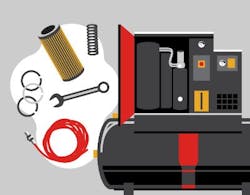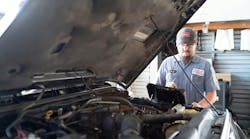Air compressors are essential to your business, but they can also become a safety hazard when used improperly. Reading your owner’s manual and following all proper safety precautions before use is vital in keeping your compressor in working condition.
To help keep your air compressor in top shape, we put together a list of common safety precautions to aide in your regular maintenance schedule:
- Place your compressor in an ideal location that has clean, dry inlet air. Wet conditions can cause damage to your machine, as well as electrical issues.
- Do not use gas air compressors indoors.
- Perform a routine safety check before each use of your air compressor. Check hoses, ensure proper power supply, check oil level, etc.
- Always wear eye protection and hearing protection when operating your air compressor.
- Do not add or change the oil or fuel in your compressor while the unit is running or has recently been used. Your compressor could potentially catch fire while doing so.
- Make sure your unit is plugged into a properly grounded electrical outlet. If not, you could potentially damage the electrical panel of your compressor and also cause a fire.
- Use the proper extension cord for your unit if needed. A cord that is longer than necessary can cause loss of power or damage to the unit.
- Check your hose fittings to ensure they are tight. Loose fittings can hinder the performance of your compressor and/or cause damage.
- Make sure your shutoff valve is visible and within reach while using compressed air.
- Don’t allow cords or hoses to be exposed in floors, aisles, or low-hanging areas. This could cause a trip hazard or injury if a hose whips.
- Never apply compressed air to your skin or directly at another person. Even air pressure as low as 15 PSI can cause serious injury.
- Do not use air directly from a compressor for breathing purposes unless the system has been designed specifically for breathing air.
- If you are using your own pressure vessel, only use those that are built to national or international standards.
- Never crimp, couple, or uncouple pressurized hoses. Shut off the unit, valves, and relieve any pressure before making or changing any hose connections.
This is not a complete list of safety procedures, as you should read your owner’s manual completely for all safety measures and proper operation of your machine.
Information provided by Chicago Pneumatic


